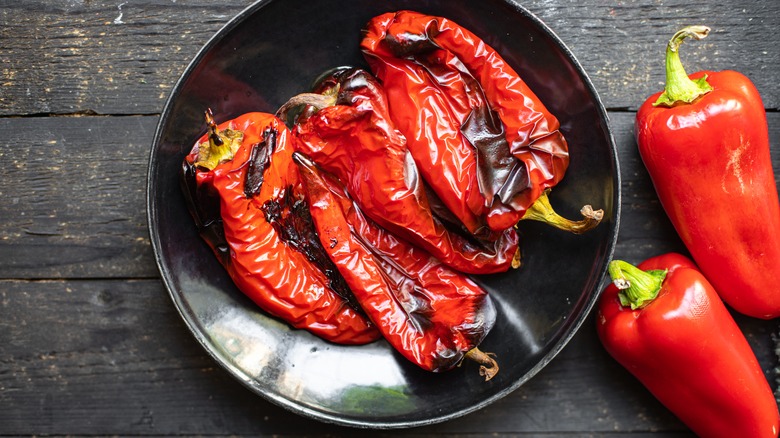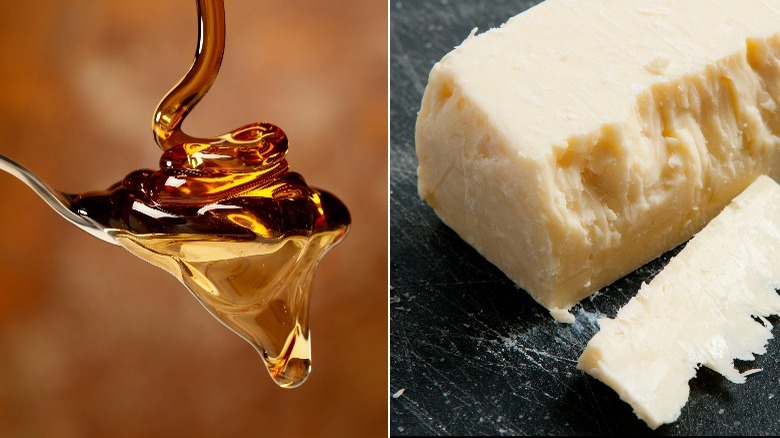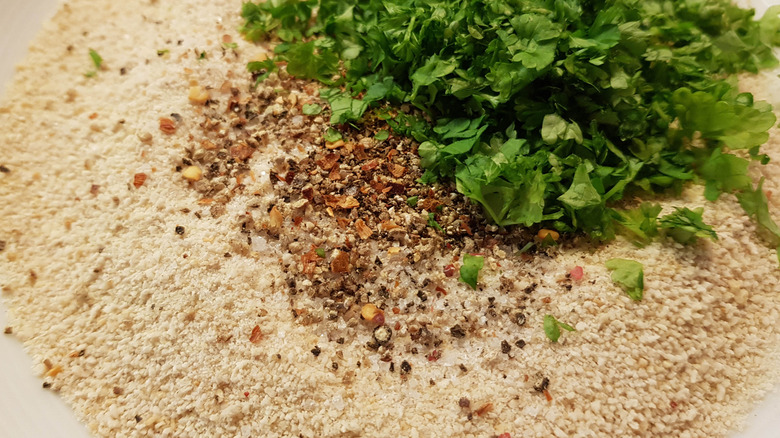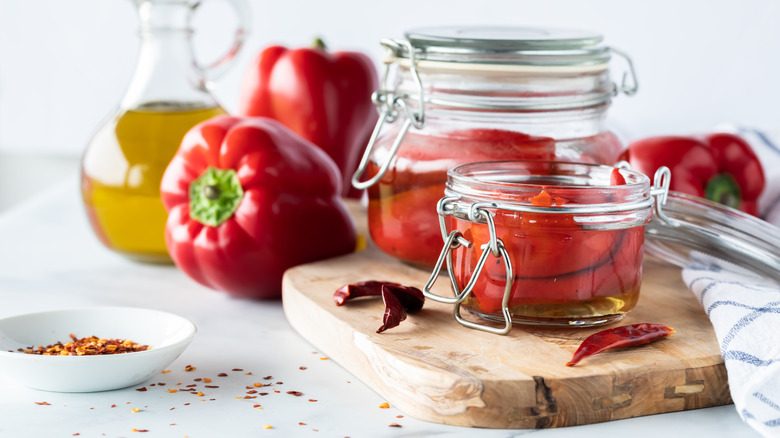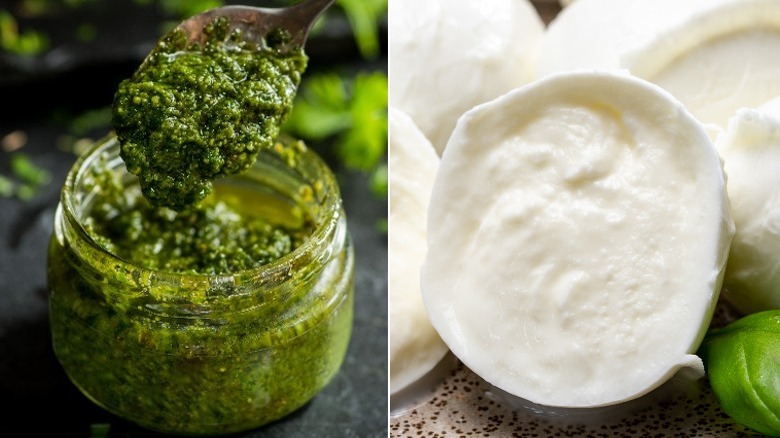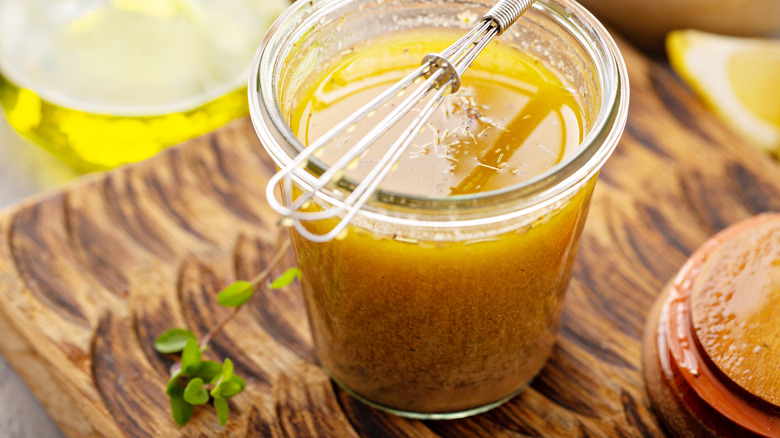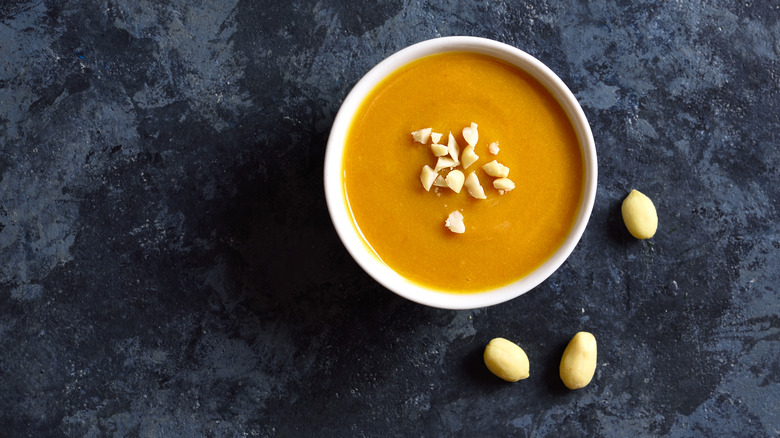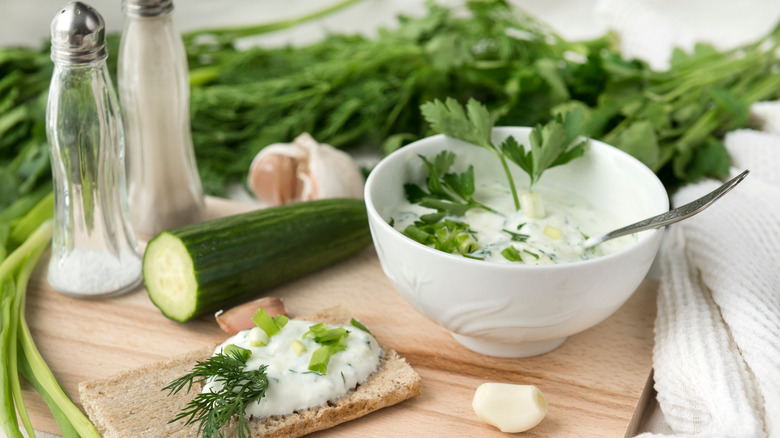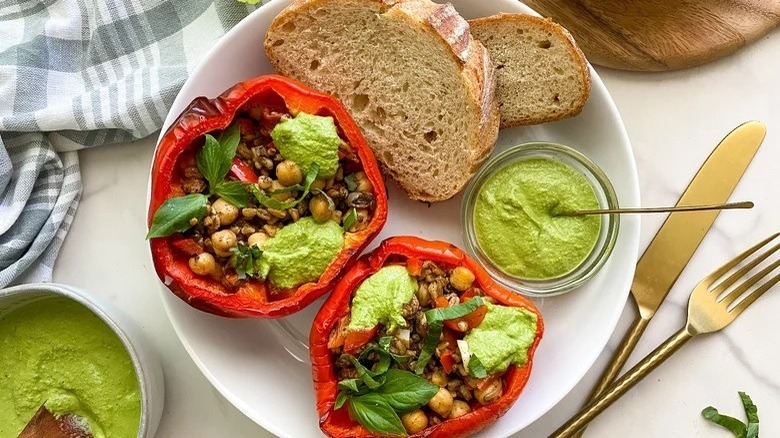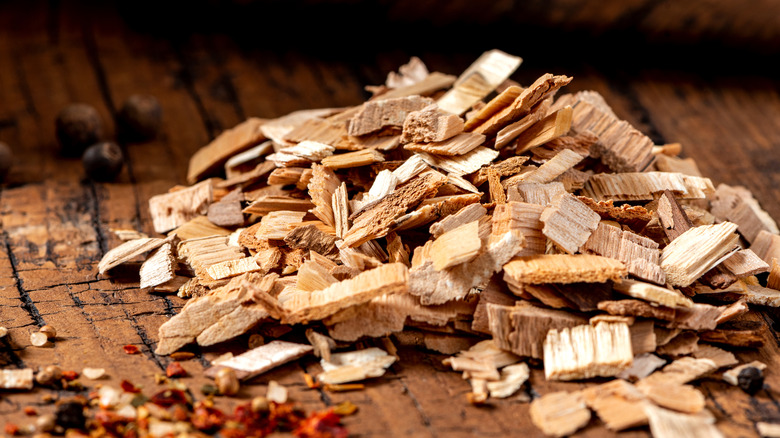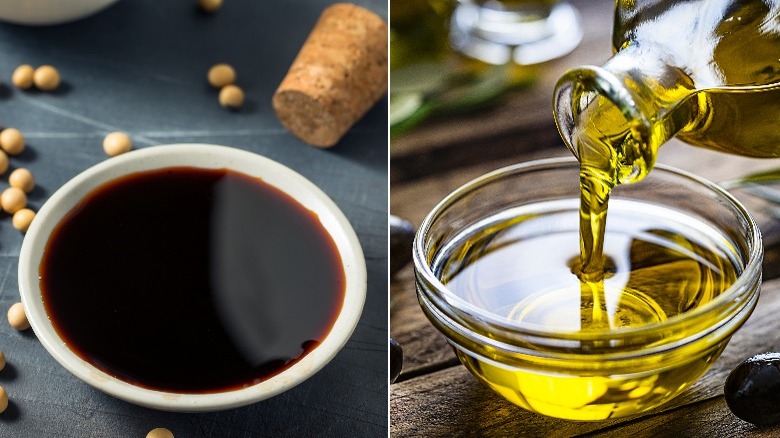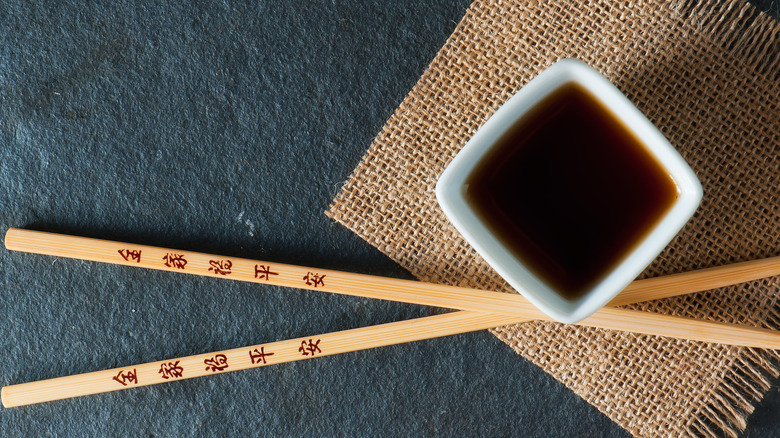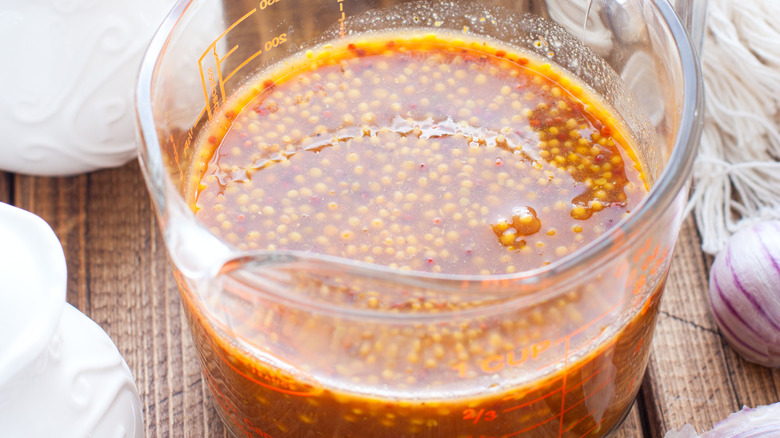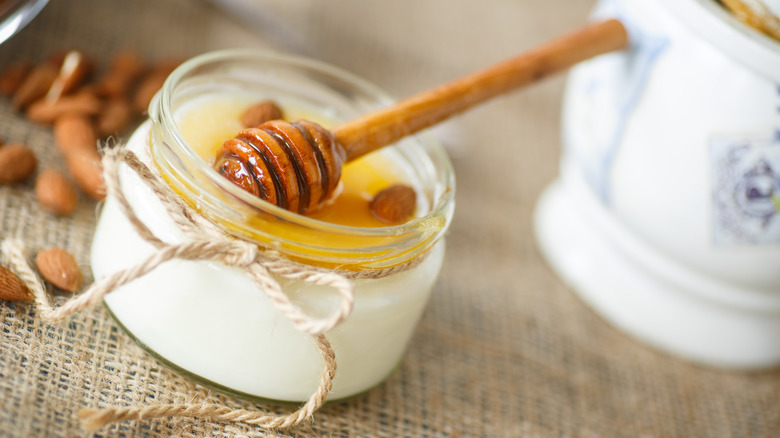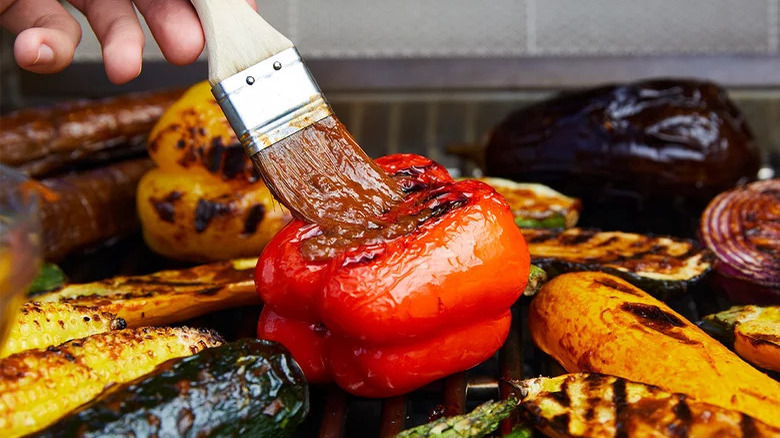14 Unique Ways To Flavor Red Bell Peppers
If you're looking for an incredibly sweet, crunchy, and versatile vegetable that also happens to be power-packed with nutrients, consider adding more red bell peppers to your diet. Now, why target red peppers specifically? Well, red, orange, yellow, and green peppers all have varying flavors and can be used in different culinary applications. This may be puzzling because these rainbows of peppers all come from the same plant, and are not, in fact, different varieties. The difference in bell peppers stems fully from their ripeness, as they start green and make their way to red at their final stage of development.
The more they mature, the sweeter they get, which allows red peppers to be flavored with both sweet and savory pairings (this is why they are so fun to prepare). You can always grill or roast them with a basic seasoning, but there are plenty of unique ways to flavor red bell peppers. These out-of-the-box additions are bound to tickle your tastebuds.
1. Maple syrup and cheese offer added sweetness and umami
Vermonters pride themselves in many culinary areas, and chief among them are their cheese-making and maple syrup-producing abilities. While the two fall on opposite ends of the flavor spectrum, they actually pair beautifully together, particularly when combined with red bell peppers.
For the cheese, you'll want to choose a meltable variety like Vermont sharp cheddar or a mild soft option like brie, or camembert. Whatever you choose, quality is key — this is not the time to use that processed orange cheese at the back of your refrigerator. Consider roasting the peppers until they are al dente and sweet, then adding a thin layer of cheese, a light drizzle of high-quality extra virgin olive oil, and just a small sticky smattering of maple syrup. After the cheese is added, throw it back in the oven to melt, and then add the olive oil, and maple syrup.
2. Add texture with herbed breadcrumbs
While red peppers are rather crunchy when eaten raw, they become incredibly soft and sweet when cooked. As their fibers break down and their sugars begin to caramelize, the result is incredibly flavorful and pleasing. This is the perfect opportunity to pair them with something crispy and crunchy, like breadcrumbs.
First, cut your red peppers into quarters, scoop out the seeds, and roast them with a little bit of olive oil, salt, and pepper until the tips begin to blacken, and the red coloring deepens. Simultaneously, bake up a batch of bread crumbs using that loaf of bread that's just on the edge. Whether you opt for butter or olive oil, don't skimp on the herbs and spices. If you're not a breadcrumb veteran, try Ina Garten's flavored breadcrumbs for an easy texture boost. Garten uses basil, garlic, sea salt, and olive oil along with white or sourdough bread to achieve the perfect crunch. Simply sprinkle your flavor-packed breadcrumbs on top and enjoy crispy, crunchy, and sweet roasted red pepper wedges.
3. Marinate in salad dressing
Who doesn't like a flavorful, well-balanced vinaigrette? It's tangy, sweet, fatty, and salty all in one package. And although we love that vinaigrette can take a salad to the next level, there are plenty of other applications for the oily sauce. That includes using the dressing as a marinade roasted red peppers, resulting in a tangy and herby flavor infusion.
Start by either broiling your red peppers in the oven, on the grill, or even on your gas burners at a high temperature, with the skin facing the heat source. Let the skin blacken, and then remove the pepper from the heat to cool. Use your fingers to peel the blackened skin from the rest of the vegetable, and grab your favorite glass jar or Tupperware. Pack the roasted pepper slices and cover them with your favorite vinaigrette. Toss the jar in the refrigerator and let it sit at least overnight to allow time for the acid of the vinegar or citrus to further break down the structure of the vegetable and for the flavor to penetrate throughout. Serve and enjoy your marinated red bell peppers on a salad, sandwich, or paired with a protein.
4. Layer with pesto and cheese
There are plenty of vegetables we enjoy layering with cheese, stacking, and diving fork-first into. While a crispy, gooey eggplant Napoleon and a refreshing tomato caprese salad are familiar favorites, peppers are also a worthy candidate for a cheese pairing, particularly when pesto enters the equation.
Roast your red peppers with any method of your choosing, and then while they are still hot, layer them with fresh slices of buffalo mozzarella cheese. Place the stacks back in the oven for just a few minutes to soften the cheese. Mix a high-quality extra virgin olive oil with pesto to thin it out, and drizzle it over the stacks, along with balsamic reduction. If you want to add a little extra texture, sprinkle the stacks with homemade breadcrumbs before you drizzle your sauces. Go one step further and use fresh basil as a garnish on top of your savory towers, and enjoy your melty, sweet, flavorful creation.
5. Use your favorite chicken marinade
One of the biggest mistakes people make when they go vegetarian or try to reduce their meat intake is that they give away their grill and put their meat-centric cookbooks in storage. Not only do vegetables love an open flame, but they also work well with your favorite marinades and sauces. And when it comes to selecting the right sauce for the right vegetable, it's all about personal preference. Lighter-flavored vegetables like zucchini and asparagus tend to do well in citrus-based sauces that typically go with white meats and fish, while darker veggies like mushrooms and eggplant tend to hold their own with steak marinades.
Red peppers do fantastically on either end of the spectrum, but we particularly like them with white meat and fish marinades. This helps their strong, sweet, natural flavoring to shine through without getting overpowered. Use an easy chicken marinade recipe, complete with both citrus and mustard flavors to help your roasted or grilled red peppers pop.
6. Dip raw strips into spicy peanut sauce
There's no denying how sweet, soft, and delicious roasted red peppers are, but the truth is that they are just as scrumptious when eaten raw. They are incredibly crunchy, juicy, and universally loved. Enjoy them plain, or flavor them with a variety of dipping sauces. They taste delicious dipped right into salad dressing, but our favorite pairing is with a spicy Thai peanut sauce.
Thai cuisine has been pairing peanut sauce with vegetables and proteins forever, and there's a reason for it. Because you'll rarely find dairy products like cheese or cream in Thai food, the nut butter along with coconut milk offer added creaminess. And boy, is peanut sauce dense and creamy. Mix your all-natural peanut butter with ingredients like ginger, hoisin sauce, garlic, citrus, chilies, and oil. Slices your red peppers up and dunk them right into the sauce before enjoying.
7. Pair with tzatziki for a Greek spin
Refreshing and creamy tzatziki is one of the absolute best sauces on the planet. Typically, you'll find this sauce accompanying Middle Eastern and Mediterranean cuisine, but it's quite versatile and can be used on a variety of dishes. A classic tzatziki sauce recipe will contain ingredients like yogurt, garlic, lemon juice, olive oil, mint, salt, and pepper. Sometimes you can find grated cucumber or sour cream in certain recipes, but the overall gist is that it's creamy, tangy, and refreshing. This is why it's so incredibly delicious paired with fatty or dense foods like shwarma or falafel.
Of course, you don't need to stick with a meaty or fried accompaniment. The refreshing texture of raw red peppers dipped in tangy tzatziki sauce makes for the ultimate summer snack. Simply slice your sweet red peppers into strips, whip up a homemade batch of tzatziki, and dip away.
8. Stuff with beans and vegetables
If you cut a red bell pepper in half, stem to base, it's apparent that this vegetable is one you should be stuffing. It's perfectly hallowed in the shape of a boat, and ready for fillings. In fact, you can slice it in half, or cut the stem off and stuff it from the top. Before stuffing your red peppers, it's a good idea to steam them first, especially if the internal ingredients don't need to be thoroughly cooked, just heated. You can steam them in the microwave with water, in a steamer basket, or even slightly bake or blanch them to get the process moving along. Now, let's get to stuffing.
When it comes to what you'd like to stuff into your bell peppers, the options are plentiful. Many people enjoy grains, like quinoa or rice, seasoned and mixed with vegetables and beans. We suggest pre-cooking vegetables, along with aromatics, spices, and your favorite beans before spooning them into the pepper and baking. However, if you're new to the game, follow an Italian-style vegetarian stuffed peppers recipe, loaded to the brim with flavor and topped with a little pesto or your favorite creamy sauce.
9. Grill with smoking chips
Because the natural flavor of red bell peppers is so delicious, it's not always a good idea to cake them with sauce. Especially if you're able to grow them freshly yourself, or grabbed them from a farmer's market or farm stand, you'll want to taste as much of that natural flavor as possible. You can do this by enjoying them raw or roasted without seasoning (or with just a little bit of olive oil or sea salt), or by tossing them on the grill.
The easy method to achieve a subtle smokey barbecue flavor is to use smoking chips in or on your grill. These chips are made from different kinds of wood that each carry different undertones of flavor. Consider using chips made from hickory, oak, maple, pecan, or alder to pair with your vegetables. Be sure to buy food-grade chips made for smoking, as they aren't treated with chemicals. Follow the instructions on the bag, and enjoy smokey, fire-roasted red peppers with a subtle hint of barbecue.
10. Roast with olive oil and tamari
Sometimes you just don't have the time to squeeze lemons, mince herbs, or toast spices, and that's okay. Luckily, red peppers aren't fussy and don't need the red carpet rolled out for them to taste incredible. A simple marinade that has stood the test of time for both roasted and grilled vegetables and meats is the fatty and salty combination of olive oil and tamari.
Simply whisk together a 1-to-1 ratio of olive oil to tamari, and coat your red peppers lightly in the mixture. If the tamari is pooling and separating from the oil, that's no problem. Keep it light, as overly oily or salty vegetables lose their luster. If you wish to take a walk on the sweeter side, add a few splashes of balsamic vinegar as well. The vinegar will reduce as it comes in contact with the heat and make a nice sticky reduction.
11. Drizzled with tare sauce
Even if you've never heard of tare sauce, if you enjoy Japanese cuisine it's likely you've had it before. It's essentially a thickened, sweet soy sauce with incredible umami undertones. It's often used for marinading meats, but can also be found in soups like Raman, drizzled on sushi, or as a dipping sauce for dumplings.
Buy it at your local grocery store in the Asian foods section, or find it at an Asian market. When in doubt you can always order some online or learn how to make Japanese tare dipping sauce all on your own. We promise it's not that difficult. However you get your hands on it, give it a try and drizzle it over roasted red peppers. The sweetness of the sauce will help to highlight the natural sugars in the cooked red peppers, and the umami flavors will add depth and bring it all together. Drizzle lightly, or use the sauce for dunking.
12. Coat with maple mustard and garlic
When it comes to grilling anything from lamb to pork to red peppers, there's a seasoning combination that is sure to captivate any audience: maple mustard and garlic. It's simple to make and uses only three ingredients that you likely already have on hand. Simply combined Dijon mustard, maple syrup, and freshly minced garlic. While maple syrup is an ideal base because of its smokey undertones, you can also use agave or honey.
Mix the three together with a little olive oil to help along the roasting process. Clean, slice, and rub your red peppers down with the sauce before popping them on the grill or in the oven. The key is to cook them long enough so that the peppers begin to soften, but the garlic doesn't burn. You simply want to release the fragrance of the aromatic and be sure to flip and turn the vegetable frequently if you're cooking over an open flame. Use a skewer and smaller cuts of pepper if you're worried about it falling through the grill. You can even layer your skewers with other vegetables or fruits dressed in the same sauce, or proteins like chicken, lamb, or swordfish.
13. Enjoy with yogurt and honey
Red bell peppers are unlike many vegetables because they are so incredibly sweet when enjoyed raw, or cooked. Each bite seems to bring a burst of sugary goodness, so it's no wonder that this bright red vegetable pairs well with fruit. In addition, you can find red peppers in combination with foods that are typically served with sweet flavors. For instance, red bell peppers can be diced raw and enjoyed with Greek yogurt and honey.
You'll want to be sure to use plain yogurt, and not a fruit-flavored, or sweetened variation. Use just a small drizzle of honey over both the peppers, and the yogurt. If that's too far-fetched for you, try roasting the peppers with honey to boost their sweetness, before letting them cool and then enjoying them with the creamy yogurt and sauce. Add olive oil to make it extra creamy, and you can even use maple syrup in place of honey for a vegan variation.
14. Lather on a fruit-based barbecue sauce
Why is it so hard to describe barbecue sauce? Perhaps it's because no two sauces are the same. They range from spicy, to smokey, to sweet, to tangy... and some contain all four of those flavors in combination. When it comes to slathering up vegetables with barbecue sauce, especially sweet ones like red peppers, we recommend a thin, sweet sauce. Bonus points if you can use one with a fruit-sweetened base.
Cherry, peach, or pineapple are worthy additions, but pomegranate molasses barbecue sauce pairs particularly well with the deep flavors of roasted peppers. These natural sweeteners carry fruity undertones, while also adding layers of flavor and depth. If you find that the sauce is at all gloopy or stiff, mix it with olive oil, or even a little fruit juice to thin it out. It should act more like a glaze or marinade than a thick sauce. This is because, unlike chicken for instance, peppers hold a lot of natural flavor which we'd like to see shining through.
Start by washing and slicing your peppers into quarters, before letting them rest in the barbecue sauce. Then transfer them to the grill and roast them at a low to medium temperature. Vegetables cook quickly, especially if they are thin, and it's best to prevent any burning or charred ends. Turn them frequently, and enjoy once they are soft and sticky sweet.
